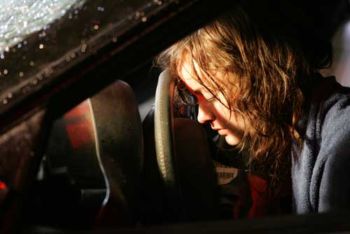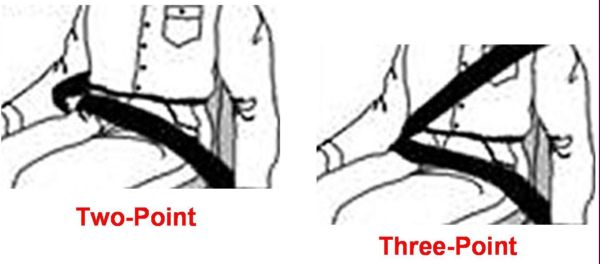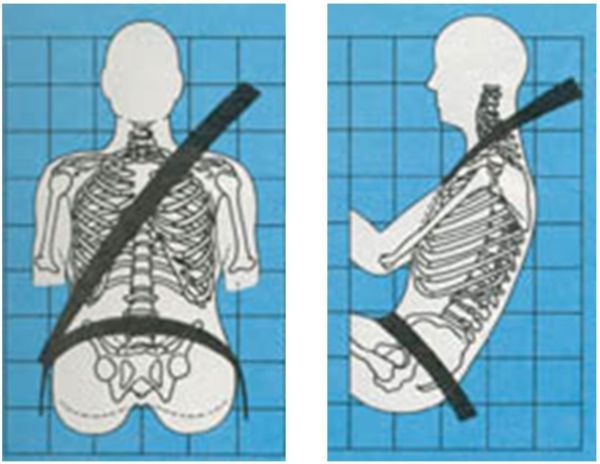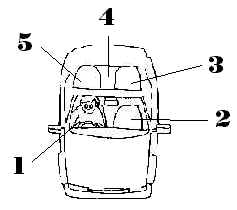Chapter 13: SEATBELTS
If two vehicles collide head on, each traveling at only 25 km/hr the inertial force on the occupants can be up to 10 times their body weight. A strong human being like a power-lifter can only control up to 3 times their body weight.
Thus wearing a seatbelt correctly is critical when driving a car. At least 90% of Australian drivers are smart enough to wear a seatbelt but many take it for granted and always wear the seatbelt as it was designed to be used.
A warning for those who persist in not wearing a seatbelt is that is any collision speed over 7 km/hr you won’t be able to prevent yourself from hitting the vehicles dashboard, and it is going to hurt.Not wearing a seatbelt in a severe crash can result in unrestrained occupants flying around making severe contact with internal surfaces, other occupants and possibly being thrown from the vehicle.
Most cars are equipped with a 3 point, inertia-reel emergency locking retractor seatbelt. What all that means is that the seatbelt once fitted is attached at 3 points, the lower belt is attached to the floor or seatbelt rail, and to the seatbelt buckle, and the shoulder belt goes down behind the plastic housing into the seatbelt reel. The seatbelt reel helps tension the seatbelt and on fast reel out like in an emergency the seatbelt has an emergency locking mechanism to lock the belt. The lap-sash system is currently the most effective way of restraining an occupant. This means that with the buckle attached to the seat; known as Auto-position front buckles the seatbelt always maintains the correct angle over the body irrespective of the seat position. This reduces the chances of the belt slipping up onto the abdomen.A vehicle designer needs to allow for a varied range of human sizes and dimensions that may drive or passenger in the vehicle.
Many vehicles will allow adjustments to seat height, seat distance from dashboard, seat inclination, steering wheel height and reach, seatbelt height. It is important before driving to adjust these for best positioning. It doesn’t take long and makes a big difference to seatbelt effectiveness in a crash.When putting the seatbelt on pull up the slack in the bottom belt and allow the reel to wind up all the slack. I even lock the emergency locking retractor when driving for added security and stability. To do this pull the belt tight and then give a quick pull or put the other hand under the belt and quickly push outwards. In this way your pre-tensioning the seatbelts yourself.The seatbelts when called on, put a lot of force on the body this force needs to be directed to rugged bony structures such as the pelvis and rib cage. Simple steps to ensure are;The seat is kept upright and sit deep in the seat to prevent submarining or sliding under the seatbelts.
Wear a seatbelt as a belt. Position the lower lap belt across the pelvis on your hipbones not across your waist and stomach. Massive internal injuries can occur in a large crash to the soft stomach region if belt is too high.
Check that the seatbelt is not twisted, if so the area restraining you is small increasing injury in this region. The belt when twisted can cut into you or leave permanent scarring. Extra seatbelt padding or covers can improve the distribution of forces. The sash belt should run naturally across your shoulder and never under your armpits.Seatbelts though are like crash helmet in that they are only designed to function once. After the severe crash the seatbelts should be examined and if necessary replaced.Some cars have special tags that pull from a plastic sleeve as the seatbelts are stretched in a large crash. Never drive a vehicle with the REPLACE SEATBELTS tag exposed.Children should always be properly restrained when traveling in a motor vehicle. It is alarming though the number of children you see unrestrained in cars. Children are not safe just because they are in the back seat. Children should never ride on passengers laps nor share seatbelts with adults or even other children. A child is only safe when seated in the correct baby or child seat for there age and size and only after this seat has been correctly mounted in the car using the anchor points provided.
ONLY 45% OF AUSTRALIAN CARS HAVE PROPER SEATBELTS THROUGHOUT THE VEHICLE
Another concern is the large majority of vehicles with only lap belts in the middle seat in the rear.Safety research and testing shows that lap-only belts, triple the risk of life threatening injury for an adult in a car crash in that seating position.In 1999, a Wheels Magazine Safety Audit of "all new passenger cars, four-wheel drives and people movers on sale in Australia showed that only 35% offer a lap-sash centre-rear seat belt".Further the study found that only 4 manufacturers (Lexus, Saab, Volvo and Jaguar) fit lap-sash centre-rear seat belt across their entire vehicle range whilst 10 manufacturers did not offer any model with a lap-sash centre-rear seat belt.It is difficult however to fit a lap-sash centre-rear seat belt to a wagon.
The Federal Office of Road Safety chief engineer Keith Seyer cites another reason why not all occupants are offered equal equipment. "The vehicle occupancy rate in Australia is about 1.3 persons. This means there is often no front seat passenger let alone anyone is the rear seat""Centre rear lap-sash seatbelts are not compulsory anywhere in the world, nor is any legislation pending"
As such if 3 people are riding in a car fitted with only a lap belt in the middle seat in the rear, it is unwise to allow the rear seat passenger to sit in the middle seat (with the inferior seatbelt) just so they can lean forward and talk better to both front seat occupants.
No matter how carefully you drive an unexpected crash can still happen.
A lap-sash seatbelt worn correctly will help minimize injuries to occupants.
(Written by Joel Neilsen, Managing Director, Safe Drive Training)







